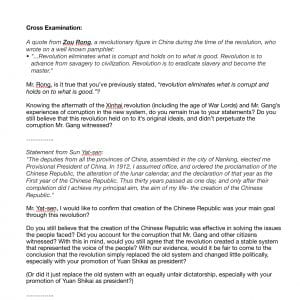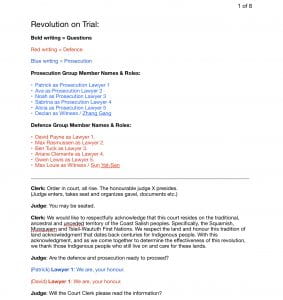
Pigs, Sheep, and a donkey. Can they really be involved in revolutions? I mean don’t they just think the worlds flat? Nope, it’s a revolution, but how? Well, I won’t actually write the answer to this question in my blog post, but this hook was apart of a keystone that I worked on in a new humanities project called “Revolution’s on trial”. The point of this project was to create a mock trail that argued whether a certain revolution was ineffective or effective. The revolutions that were put on trial were Xinhai, French, American, and Haitian. Furthermore, this project’s driving question was “How can we, as legal teams, determine the effectiveness of a revolution?”. To answer this question I really tried to create keystones that were correctly based off of a successful criteria. Furthermore, I tried to completely understand the Xinhai revolution, by the use of reading strategies to summarize topics, as well as clearly express topics. I also had lots of work that was put into this last project of the year, so I hope you enjoy!
To start of this project we did a Nation X simulation. The point of the Nation X simulation was to learn how it felt to be in a society that had unfair rulers, and it was basically a symbolism of the ‘Incubation stage’ of a revolution. The length of this simulation lasted for ‘4 days’ (2 classes). To start of the day the lower classes, group A and B, got a rumour and a news paper. We then got payed and continued about our day. Before nightfall we would have to pay our taxes, at unfair amounts I might add, but our work was basically gone due to the amount of taxes we had to pay. The main rules we had to follow, was that as lower classes we weren’t allowed to leave our territories. Then for the assignment on the Nation X simulation I wrote a reflection from the perspective of a journalist in the lower class. Throughout the reflection we were supposed to answer this question prompt: “Having completed the Nation X simulation, were you able to create a fair and functional society? Why? Why not?. What is necessary to ensure a fair and functional society? Is there any one thing that is needed above all else?”. I answered this prompt throughout my Nation X reflection.
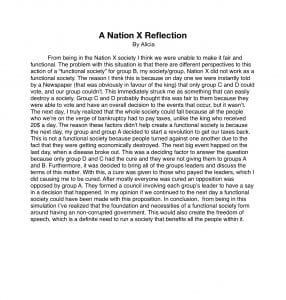
Secondly, I moved onto the creation of the Crane Briton Diagram. To create the diagram I had to understand Crane Briton’s Theory of Revolutions. I learnt that the theory explains what a revolution contains. The theory contains four stages the incubation, moderate, crisis, and recovery stage. I then toke my knowledge about this theory and create my own diagram that represents these stages. To correctly define and display the theory I create a keynote magic move video. Overall, this point in the keystone help me showcase my understanding of Crane Briton’s Theory of Revolutions, which I think helped me with the other parts of this project.
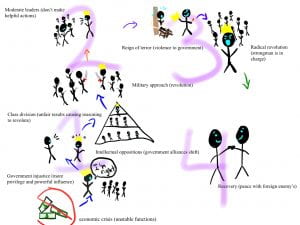
After comprehending the theory of revolutions I started to form my graphic organizer. To create the graphic organizer we were tasked to separate our knowledge about the revolution and sort it under certain sections. These sections were Underlying Events, Continuity and Change, Key Characters etc. Of course we had to take many steps before I could create a accomplished graphic organizer. Firstly, we were given a revolution to study and I was assigned with the Xinhai revolution. I then was given sources to look through and take notes, that toke a very long time, but it was super useful for the final product of the project.

Once I finished my notes I started to create my graphic organizer. At first I thought a flow chart would be a good design, until I realized it’s hard to separate it into sections. With this failed attempt I thought I would create my own graphic organizer, which is exactly what I did. Throughout my individual graphic organizer I tried to tell a story (plot line) to the Xinhai revolution. The way I did this was by including some of the stages of Crane Briton’s theory into the graphic organizer (such as the underlying events and the turning point). To make my graphic organizer hold more information I included my own sections (goal/point, locations, and sources). With all of these sections created I was also tasked to explain the effectiveness and ineffectiveness of this revolution. From my experience with this project I now understand that this was very important because these to concepts are what we argued in the mock trail.

To continue with this project we all read Animal Farm by George Orwell. The reason we read this book was to move onto an important part of a keystone, the animal farm written analogy. Yet, there was some other work needed to be done before we could move on to the analogy. We first read the book animal farm and had chapter discussions. From my perspective I actually enjoyed the book and read it on my spare time. The reason I liked it was because I was able to clearly connect it to the process of a revolution (which was very helpful during my written analogy). Animal Farm is a book about a revolution that takes place throughout a group of animals. These animals are in a farm, which is run by a drunk man named Mr.Jones, and they are treated poorly making them revolt and turn towards animalism. Of course there is other events that happen within this book, which really makes it more realistic, as well as given the plot a time to turn. Once I finished this book I was able to move onto the Animal Farm Written Response.
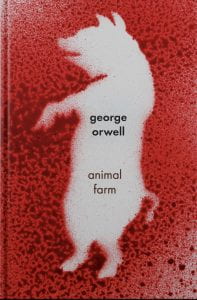
The Animal Farm Written Analogy was about writing in class about the connection between animal farm and Crane Briton’s Theory of Revolutions. To create the this analogy I created an outline. This was actually similar to the multi-paragraph outline and writing assignment that I did in a previous project called People in the Environment. The outline I created was meant to help me answer the prompt: “Explain the anatomy of the revolution in Animal Farm through use of Crane Brinton’s Theory.”. Throughout my outline I tried to including key argumentative points that I could use during the in class writing. This outline sorted my key points into a hook, introduction, topic sentence, evidence 1 and 2, topic sentence, and conclusion. I really think this outline was important because I was able to give myself a pathway to write a proper multi-paragraph response.
The animal farm written analogy was a multi-paragraph response that was meant to show how Animal Farm uses Crane Briton’s Theory of Revolutions (I’m aware I stated this before, but I guess I just have to let it sink in). As an example of what I wrote within the paragraphs, I stated the connection between a certain stage and how it was in animal farm (just like the incubation stage): There’s a lasting unfair economic crisis, as well as government injustice, when old major states in his speech when he states “Let us face it, our lives are miserable, laborious and short. We are born, we are given just so much food as will keep the breath in our bodies” – Statement inserted from multi-paragraph response. Overall, this supporting factor to the keystone helped me comprehend and connect certain pieces of evidence to one another. Even though I did connect with solid evidence I feel like my final product could be improved by adding more revolutions to link with animal farm. Yet, I think this was a great representation of my understanding of how to use strategies to connect text.

Once we concluded with the learning new information topic we were tasked to create an affidavit. An affidavit is a sworn statement in writing made especially under oath or on affirmation. This is something we had to create that we could uses as evidence in court. Before this could happening we spilt up into two groups for the mock trial, defence and prosecution. My group was put into prosecution, meaning we had to argue that the Xinhai revolution was ineffective. Continuing in this project, as the prosecution team, we had to make an affidavit that included certain pieces of evidence from people’s experience within the revolution. From our experience it took quite long to make a this affidavit that could make us reach this goal. Then after a lot of drafts we were able to take evidence directly from the source of someone who was involved with the revolution. Once our team and the other team (defence) were finished we swapped our affidavits, so we could understand what each of us were arguing. With this we were able to start our cross examination questions, which were very helpful in creating the script.
After the creation of the affidavit we were tasked to choose a witness and develop questions form them. The witness we chose was Zhang Gang, a mediator for conflicts between villagers, and he gathered information from fellow scholars. We found this information in an article about him when we were researching information for our affidavit. Once we picked him to be our witness we devolved questions for him, that we would answer with the data we collected. These questions were supposed to be used in the mock trial to show how he was involved in the revolution. Then after those questions were made we made cross examination questions for the defence’s witness, Sun Yat-Sen. We tried to make questions that would prove that that revolution was unsuccessful.
Once all of this was done both of our teams came together to make a script for the mock trial. To make our script interesting we added objections and carefully curetted questions that would help enhance the project. The script contained multiple sections such as the closing and opening statements, cross examination questions, and witness questions.
We then move to the performance of the mock trial. Before we could do the final mock trial on the day of the PLP Winter Exhibition we had to do a few rehearsals. Within our rehearsals we practiced what positions we would take over on and off the stage. During the performance I was a lawyer, for prosecution, and I said the closing statement to the jury. During the American, Haitian, and French Revolution we were doing roles to keep the theatre working smoothly. These roles were things such as looking around the exhibition, practicing in the green room, or taking place as specific roles. These specific roles were being held for the performance that was active. Furthermore these roles were ticket booth (which I was) Usher, Technical booth, stair greeters, and slide show person. With all of this work being needed I’m glad we did rehearsals because we were able to focus on what aspects we had to improve on for the final performance.

Finally, we moved onto the actual performance of the mock trial. I realized I didn’t mention this before, but I feel I should bring upon the question of what is a mock trial? Well… a mock trial is a planned version of a legal trial that would be held. Hence the reason we had rehearsals to benefit our presentation. From my experience with the matter I was actually really surprised at how well it went. The reason I said this is because from some transitions within our rehearsals I felt we might’ve not preformed very well, but we did. Both sides, prosecution and defence, had arguable cases that were portrayed eventfully with supporting evidence. Even though the jury decided that the revolution was effective I still thought our argument was more than worthy of an consideration of benign ineffective.
Overall, this project has taught me important knowledge about the revolutions, reading strategies (and how to incorporate them into writing assignments), and Oral Language Strategies (including how to act out information that connects to the audience). These skills were very important throughout this project, but I also tried to improve my understanding about the curricular competencies, Continuity and Change, and Connecting, because I know they would help me understand certain concepts about this project. As I reflect on this project I realized I built upon the competency, Continuity and Change, because I used it during the determination of the effectiveness of the Xinhai revolution. I also built my use of Connecting because throughout the writing process I truly had to understand how to connect one subject to another. With this I feel I strongly built my correct use of the curricular competencies for this project.
Since I’ve reached the end of this project I’ve developed an answer to the driving question, “How can we, as legal teams, determine the effectiveness of a revolution?”. My answer is that to develop legal teams that can determine effectiveness of a revolution revolves around having supporting evidence to a cause. Throughout my legal team I noticed that we each contributed to learning information about our revolution and making that information intertwine into a piece of evidence that could be used in court. Furthermore, to determine the effectiveness of a revolution a legal team must follow the proper procedure of a legal court case. Overall, legal teams can determine the effectiveness of a revolution by showcasing evidence to those appraising their conflicts.
That is my answer to this important driving question. What is yours?
– Alicia 😄
Credits:
Shout out to the Xinhai revolution prosecution team:
Photo Credit: Member’s of PLP 9
Animal Farm: Wikipedia

